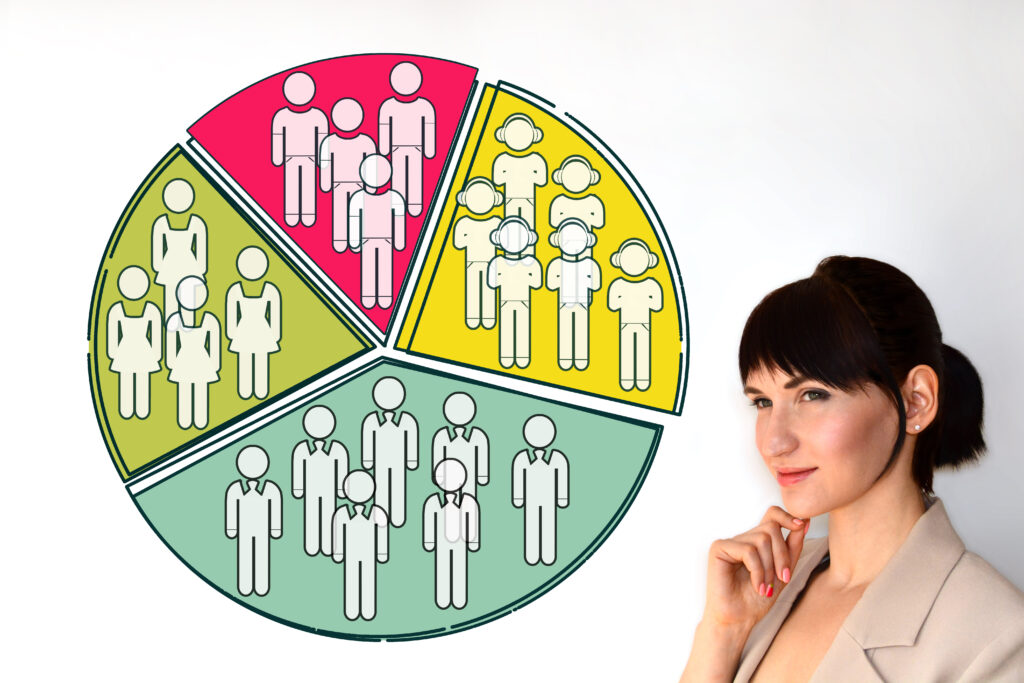Audience segmentation is a powerful tool that enables you to deliver targeted, relevant messaging to the right audience at the right time. Email marketing improves open rates and deliverability. It also helps you build relationships with customers because you are not sending every message to your entire list but tailoring your messages based on their behavior and preferences.
This short guide to audience segmentation explains what it is, why it matters, and how you can use it to grow your business by engaging customers more effectively.

What Is Audience Segmentation?
Audience segmentation is an advanced marketing strategy that divides your audience into targeted groups based on their needs and wants. It allows you to deliver tailored messaging and build better customer relationships.
There is no single best way to segment your audience. It will depend on the size of your contact list, the products or services you sell, and what you need to communicate. Subgroups can be based on demographics, behavior, purchasing stage, or psychographics (values, beliefs, personality).
Successfully utilizing segmentation requires a solid understanding of your audience. You want to create segments with distinct needs, wants, and expectations. This allows you to create content that speaks to your audience, meets their needs, and reflects their desires, interests, or values.
Audience segmentation is an advanced marketing strategy because it requires a larger audience and a more refined understanding of contact groups. It also means creating individualized messages for different segments.
Benefits of Audience Segmentation
Using audience segmentation, you can avoid generic or bland offers that may turn customers off or not catch their attention. It makes your ads and messages seem less like intrusive advertising and more like helpful content, which improves the chances you’ll get the response or behavior you want.
Benefits of audience segmentation include:
- Increased conversion rates
- Increased engagement
- Increased customer satisfaction
- Increased loyalty
Understand Your Audience
If you already have one or more customer personas, that is a good place to start. A customer persona is an individual (usually made up) who represents an audience segment or target audience. Usually, your customer persona will include a name, photo, and personal details like income, marital status, career, hobbies, pain points, and motivation.
However, unless you recently developed your customer persona using in-depth research based on your company’s data, don’t segment your audiences purely on that. It’s important to dig into the demographics and buying behavior of your customers so you can create meaningful segments with distinct targeting differences.
Some businesses have obvious segments. For example, if a backpack company had a line for kids and teens in school and then a separate line for outdoor enthusiasts, the audience could be segmented into customers who shop for school, customers who shop for outdoors, and customers who have purchased both.
Other audiences may not be as intuitive. For example, a blender manufacturer may discover that while most people who buy their product are women between 35 and 60, there are distinct differences in their values and preferred language based on geographic location.
Examine the data and information you have on your audience and their buying behaviors. Things you can review include:
- Pain points and how different customers are affected
- Demographics (location, age, gender, family status, occupation)
- Knowledge and behaviors
- Customer journey (is there a significant portion of your list who have yet to buy?)
- Psychographics (values, beliefs, attitudes, aspirations, opinions, lifestyles)
- Any possible distinctions relevant to your products or industry
The next section dives deeper into these and other segmentation criteria.
Common Ways to Segment Your Audience
As you go through your audience, keep in mind that while segmentation is valuable, you want a function balance. You will create tailored messages for each segment, so you’re looking for meaningful groupings. Here are six ways to look at your audience for possible segmentation.
Demographics
Demographics is an easy way to divide your audience and tends to be the most frequently used because it works. Age, gender, income level, and job type are all simple ways to sort your audience.
Demographic segmentation can be useful when you target an ad campaign. For example, say men between 22 and 30 who make at least $60,000 a year or men between 40 and 50 who make at least $100,000 a year are more likely to buy sports cars than other demographics. You can target these groups with advertisements for hot, high-powered sports cars.
Geographic Segmentation
Technically, location falls under demographics. However, it is so significant it deserves its own section.
Location-dependent variables like population, climate, and culture allow you to enhance the customer’s buying experience by presenting them with the products and advertising most relevant to their wants and needs.
Seasonal Segmentation
Do your customers in Florida need snow boots in December? Do your customers in Seattle ever stop needing rain gear? The weather has a significant influence on buying habits. If you sell over a large geographic area with different seasonal experiences, you can target your marketing by location and season to capitalize on people’s weather-based purchases.
Seasonal segmentation also applies to purchases made at the same time every year. For example, Christmas decorations are a seasonal purchase. Paper plates, picnic baskets, and disposable cutlery might be more popular during spring, summer, and fall — depending on the weather in a specific location.
Behavior
Behavior is a more complex segmentation strategy. It refers to what your customers buy, how frequently they make a purchase, and what motivates them to buy.
A customer who trades in their car lease for a new one every two years might respond to different messaging than one who buys a car and drives it for five to ten years. These two customers are looking for different things and have different motivations.
Another example of behavior segmentation is shoppers who only make purchases during sales events versus those who like to get the new model before anyone else has it.
If you have old customers who haven’t engaged with your brand for a while, you can send them a “win back” message. This is an offer or invitation that tempts them back into a relationship with your business.

Buyer’s Journey Progress
The buyer’s journey is a specific subset of behavior. There are three primary steps in what marketers call “the buyer’s journey.” First, they are aware of what they need. Then they consider their options. Finally, they are ready to make a decision and buy. So, the three stages are:
- Awareness
- Consideration
- Decision
A buyer in the first stage wants information. In the second stage, they want to be able to compare options — for example, different models or features. In the final stage, they have some idea of what they want and are more likely to jump on a good offer or opportunity.
Segmenting prospects by their stage in the buyer’s journey can build a pipeline that nurtures leads into customers.
Psychographic Segmentation
Psychographic segmentation narrows down your audience based on interests, beliefs, opinions, and lifestyle rather than demographics like age or gender. It can be a little more complex to master, but your audience will feel like you are talking directly to them when you get it right.
Marketers who want to target specific niches within their larger market often use psychographics. They may tailor the advertising hook for a product or service based on the audience’s interests.
For example, one ad for a washer/dryer combo that targets a younger audience might emphasize simplicity and freedom or show how easy it is to get your clothes clean and smelling fresh after an adventure trip with your friends. The same machines sold to a family-oriented audience might emphasize their durability and affordability.
Audience Segmentation Tips
Here are a few audience segmentation tips to keep your team on track.
Double Check Your Work
Use these four criteria to make sure your groupings are valuable.
- Is this segment relevant to my business and likely to engage with my business? Do they have a problem my products or services can solve?
- Is this segment unique and distinct from other segments? Can you combine it with another grouping, or does it have characteristics that stand out?
- Is this a big enough group to be worth targeting?
- Where does this group spend their time? Can you find them through email, social media, advertising, direct mail, or another marketing channel?
Don’t Focus Too Narrowly
Keep your audience segments broad enough that they are well-populated. The point of audience segmentation is to narrow your focus, but if you get too defined, you divide your resources and put valuable marketing effort toward insignificantly small audiences.
If you find your audience segments are getting too small, step back a level and make your segment broader. For example, instead of “women between 40 and 50 who purchase once a month,” you could step back to “women between 35 and 55 who purchase at least eight times a year.” If that’s still not a big enough audience, look at including men, decreasing the purchase frequency, or finding other meaningful criteria to use aside from age and gender.
Don’t Set It and Forget It
When you get your audience segments right, it will translate into exciting improvements in your marketing ROI. Don’t assume you nailed it perfectly on the first try. Measure your data and observe who is responding to your campaigns. Likely, you’ll consistently see ways to improve your segmentation and messaging over time.
Measure Your Progress
What are your goals in segmenting your audience? Do you want to increase purchase frequency, grow your audience, or improve click-through rates? Quantify measurable goals at the beginning of your process and track them so you know where you stand and can make changes if necessary.
Segmentation Saves Money and Builds Relationships
Audience segmentation lets you focus your marketing efforts where it can make a difference to your bottom line. By segmenting your audience and understanding their behavior, you can put the right message in front of the right people at the right time in a laser-focused manner.
Once you’ve identified your audience segments, you’re ready to utilize targeted advertising and marketing strategies. You can apply your audience segments to any marketing strategy you use, including social media, email, direct mail, and advertising. If you have any questions about audience segmentation or how to get the best ROI on your marketing budget, J&L Marketing is here to help.


